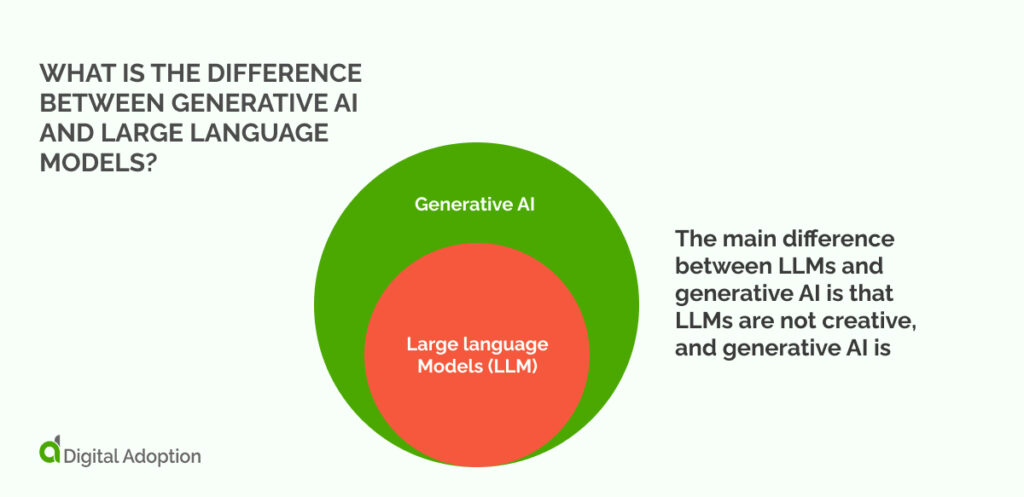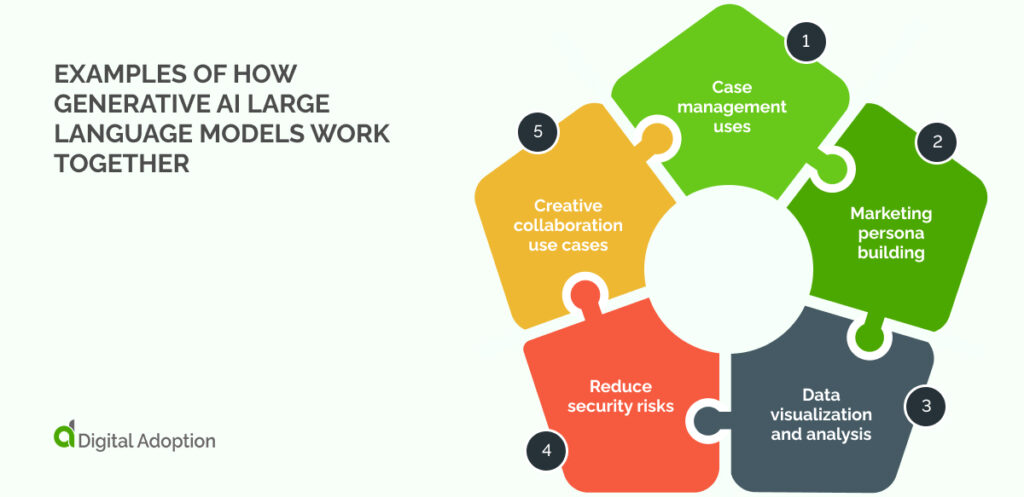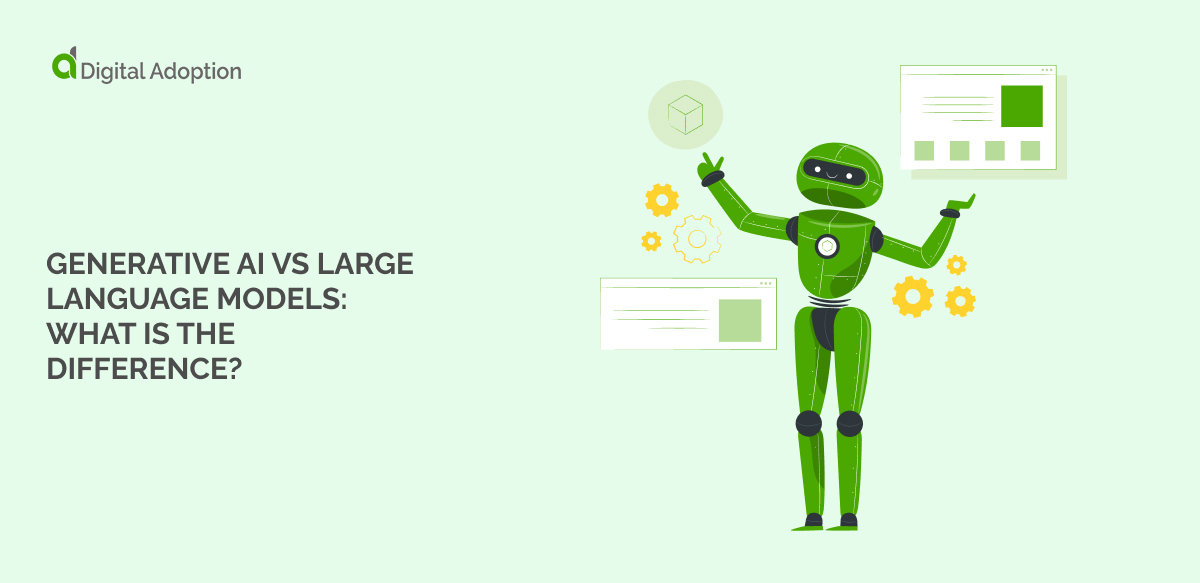Generative AI and large language models (LLMs) go hand in hand, but only if you know the differences.
In 2023, almost a third of companies were using generative AI in some form. In contrast, 58% of companies in the same year began experimenting with large language models, but only 23% planned to implement them soon. The hesitation was due to concerns over privacy and ethics.
These AI adoption statistics show that organizations should not take AI implementation lightly. It can negatively impact your organization and employee well-being if you don’t learn the differences as you compare generative AI versus large language models before implementing either.
This article is written to help organizations learn the differences between generative AI and LLMs to avoid the negative impact of their implementation. We will guide you through the definitions of each AI type, their differences, and AI examples of how these technologies can work together.
What is generative AI?
Generative AI collects large amounts of data to quickly and cheaply generate high-quality paragraphs, images, and music. Enterprises use it to answer customer support queries, create advertising images, and send email outreach.
ChatGPT by OpenAI, Gemini by Google (previously Bard), and Copilot by Microsoft are the three most popular generative AI applications.
What are large language models (LLM)?
Large language models (LLMs) are foundation models that collect large amounts of data to recognize and interpret human language or other intricate data types.
Many LLMs receive training on vast amounts of internet-acquired data. However, the efficacy of LLMs in learning natural language depends on the quality of these samples, prompting programmers to opt for a higher-quality dataset they source from elsewhere.
LLMs are transforming diverse fields, including chatbots, virtual assistants, limited content creation, research support, and language translation.
What is the difference between generative AI and large language models?

The main difference between LLMs and generative AI is that LLMs are not creative, and generative AI is.
The reason is that LLMs specialize in comprehending and generating text-based content, leveraging extensive training on language datasets.
In contrast, Generative AI encompasses a broader range of creative tasks beyond text, such as image synthesis and text composition. Both can be used in different ways to achieve a successful AI-driven digital transformation.
While LLMs excel in narrower, language-related tasks, Generative AI offers versatility across multiple modalities, catering to diverse creative endeavors. In this way, generative AI is broader than LLMs, so it encompasses it within a wider definition and more use cases. LLMs, on the other hand, have a smaller group of narrow use cases.
IMAGE
The differences between these two AI types become clearer when we place them in a table to compare attributes:
| Parameters | Generative AI | Large Language Models (LLMs) |
| Content type | Generative AI can create images, music, code, and content besides text. | LLMs excel at text-based tasks such as natural language understanding, text generation, language translation, and textual analysis. |
| Data availability | Generative AI requires diverse datasets for different types of content. | LLMs work specifically with text and are a good choice if you have extensive text data. |
| Task complexity | Generative AI suits complex, creative content generation and tasks requiring diverse outputs. | LLMs specialize in language understanding and text generation, offering precise and coherent text-based responses. |
| Resources and model size | Larger generative AI models demand more computational resources and storage. | LLMs, specialized in language understanding, might be more efficient for text-focused tasks. |
| Training data integrity | High-quality, diverse training data is crucial for generative AI to generate meaningful and creative outputs. | LLMs need extensive, well-organized text corpora for effective language understanding and generation. |
| Industry use case domain | Generative AI is ideal for creative fields such as marketing, advertising, and content creation. | LLMs are well-suited for natural language processing applications like chatbots, content summarization, and language translation. |
| Developmental expertise | Developing and fine-tuning generative AI models can be complex and requires expertise in machine learning and domain-specific knowledge. | LLMs, particularly pre-trained models, are more accessible and user-friendly for text-based tasks need less specialized expertise. |
| Ethics and privacy | Generative AI outputs are subjective. Consider ethical concerns regarding AI models, particularly if generating content or answering sensitive questions. It is prone to political bias, poor research, and factual inaccuracies. | LLMs usually adhere to specific ethical guidelines and are immune to generative AI’s ethical challenges. |
Generative AI encompasses numerous tools designed to utilize information from LLMs and other AI models, employing machine learning to create new content. An LLM, in particular, is an AI model that leverages machine learning, built on billions of parameters, to comprehend and generate text.
Consider these differences when you are looking to invest in one for a specific use case.
Examples of how generative AI large language models work together

Generative AI and LLMs are similar in the way they operate. You can use them together in various ways while avoiding generative AI risks and the challenges of LLMs. These tools enhance creativity and precision, enabling diverse content creation with advanced language understanding and generation.
Case management uses
A customer asks a case worker a question about their case. Rather than going through each email, document, and chat transcript to find an answer, the case worker asks a large language model to provide a summary of data related to the question.
The LLM provides a textual overview of the key players, case highlights, and suggested next steps. In this scenario, the customer was also having technical trouble uploading documents to their case, so the case worker used a generative AI-powered video creation tool to send them a video walkthrough of the process.
Marketing persona building
Generative AI for sales can be a sales and marketing team’s best friend when they want to create a synthetic audience persona via generative AI.
They prompt an LLM with questions like “Where does my persona get their news?” or “How does my persona like to be communicated with?” and use the responses to craft a story about their persona.
Generative AI can analyze vast customer data, including demographics, purchasing behaviors, and online interactions, to create realistic and diverse persona profiles. LLMs can then interpret and refine these profiles, generating detailed narratives and insights about each persona’s preferences, motivations, and pain points.
This combined approach allows for more nuanced and accurate personas, enabling marketers to craft personalized and effective campaigns. By continuously updating these personas with real-time data, enterprises can stay attuned to shifting customer needs and behaviors, optimizing their marketing efforts.
Data visualization and analysis
You can combine generative AI and LLMs to enhance data statistics and visualizations, providing a powerful toolset for data analysis. Generative AI can process large datasets, identifying patterns, trends, and correlations that might not be immediately evident.
Once the tool has identified these patterns, LLMs can generate comprehensive, natural language summaries and explanations of the data, making complex statistical concepts accessible to non-experts.
LLMs can create detailed scripts for visualizations, guiding the generation of charts, graphs, and other visual aids. This synergy ensures data is accurately analyzed and effectively communicated, enabling better decision-making and strategic planning across various fields.
Reduce security risks
Combining generative AI and LLMs can significantly reduce security risks by enhancing threat detection and response. For instance, generative AI can simulate various cyber-attack scenarios, creating a comprehensive dataset of potential threats.
LLMs trained on this dataset can then analyze network traffic and communications to identify unusual patterns indicative of an attack. Additionally, LLMs can generate detailed reports and automated responses to detected threats, streamlining incident management.
This integration allows for a proactive and intelligent security framework, continuously learning from simulated scenarios and real-world data to effectively anticipate and counteract evolving cyber threats.
Creative collaboration use cases
Generative AI technologies often collaborate with artists, designers, and musicians to produce innovative and engaging content. Meanwhile, Large Language Models collaborate with researchers, developers, and content creators to enhance language understanding and generate informative text.
Companies like OpenAI collaborate with research institutions and industry partners to enhance LLM capabilities and develop innovative applications in natural language understanding and generation.
Consider these ways to combine generative AI and LLMs. Which would be relevant to your organization, and how could you adapt them to solve organizational challenges? It is essential to know how to use these technologies together to leverage their potential and overcome competitors’ use of AI.
Research generative AI and LLMs to optimize your use of each
To unlock Generative AI and Large Language Models (LLMs), you must do some research. You need to understand how they work together and how they differ.
Generative AI is great for creativity, like content creation. But, it has many ethical issues. LLMs are better for chatbots and language translation. Understanding these differences is key to unlocking the success of each within your needs.
Delving into the nuances of generative AI unlocks its full potential. Businesses can leverage its creative capabilities for tasks like personalized marketing campaigns.
Large language models (LLMs) offer precise language solutions, enabling real-time translation or other communication needs. This comprehensive approach optimizes your investment in AI, driving innovation across various domains and ultimately leading to higher revenue success.









